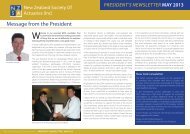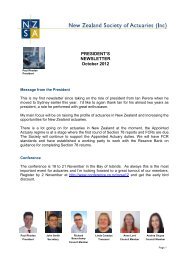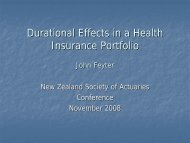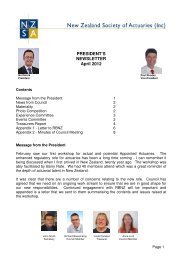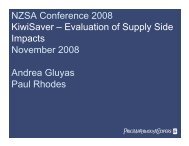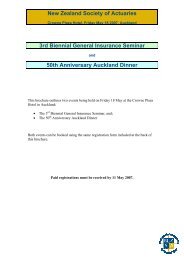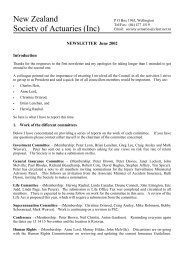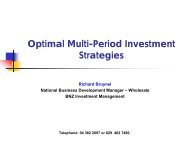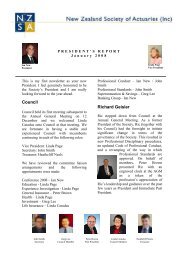Risk Margins Survey - New Zealand Society of Actuaries
Risk Margins Survey - New Zealand Society of Actuaries
Risk Margins Survey - New Zealand Society of Actuaries
Create successful ePaper yourself
Turn your PDF publications into a flip-book with our unique Google optimized e-Paper software.
www.pwc.com/nz<br />
<strong>Risk</strong> <strong>Margins</strong> <strong>Survey</strong><br />
General Insurance Seminar<br />
October 2011<br />
Ross Simmonds &<br />
Jonathan Nicholls
Agenda<br />
What is the <strong>Risk</strong> Margin <strong>Survey</strong>?<br />
What has been the impact <strong>of</strong> recent major events?<br />
What are the key findings <strong>of</strong> the survey?<br />
<strong>Risk</strong> <strong>Margins</strong> <strong>Survey</strong><br />
pwc<br />
October 2011<br />
Slide 2
What is the <strong>Risk</strong> Margin <strong>Survey</strong>?<br />
<strong>Survey</strong> run by PwC since 2005<br />
NZ General Insurers detail their risk margin methodology & numbers.<br />
Results provide GI industry with:<br />
• Awareness <strong>of</strong> emerging developments and trends<br />
• Ability to benchmark<br />
<strong>Risk</strong> <strong>Margins</strong> <strong>Survey</strong><br />
pwc<br />
October 2011<br />
Slide 3
What is the <strong>Risk</strong> Margin <strong>Survey</strong>?<br />
Ten Participants this year<br />
ACC, ACE, Allianz, AMI, Chartis, FMG, IAG, Lumley, Southern Cross<br />
and Vero all submitted survey responses.<br />
We thank all ten insurers for taking the time to participate.<br />
<strong>Risk</strong> <strong>Margins</strong> <strong>Survey</strong><br />
pwc<br />
October 2011<br />
Slide 4
What has been the impact <strong>of</strong> major recent events?<br />
Key Changes since the 2009 <strong>Survey</strong><br />
Look at the impact <strong>of</strong> recent major events on risk margins. Last couple<br />
<strong>of</strong> years have seen:<br />
• Insurance (Prudential Supervision) Act<br />
• Canterbury Earthquakes<br />
• IAA <strong>Risk</strong> <strong>Margins</strong> Taskforce paper<br />
<strong>Risk</strong> <strong>Margins</strong> <strong>Survey</strong><br />
pwc<br />
October 2011<br />
Slide 5
What has been the impact <strong>of</strong> major recent events?<br />
Insurance (Prudential Supervision) Act<br />
Major regulatory reform, but has not significantly altered insurers<br />
approach to risk margins.<br />
Only change noted due to the new regulatory framework is around<br />
aligning business classes to match the non-life solvency standard.<br />
<strong>Risk</strong> <strong>Margins</strong> <strong>Survey</strong><br />
pwc<br />
October 2011<br />
Slide 6
What has been the impact <strong>of</strong> major recent events?<br />
Canterbury Earthquakes<br />
The earthquakes led to significant property damage. Some insurers<br />
have separated these claims from the rest <strong>of</strong> the property portfolio.<br />
In the results <strong>of</strong> this survey, liabilities arising from the Canterbury<br />
earthquake have been excluded.<br />
Catastrophe liabilities may require a different risk margin due to:<br />
• Greater uncertainty<br />
• Reinsurance coverage<br />
<strong>Risk</strong> <strong>Margins</strong> <strong>Survey</strong><br />
pwc<br />
October 2011<br />
Slide 7
What has been the impact <strong>of</strong> major recent events?<br />
IAA <strong>Risk</strong> <strong>Margins</strong> Taskforce paper<br />
This paper was written in 2008 by Marshall, Collings, Hodson and<br />
O’Dowd. It was mentioned by respondents last time as being a potential<br />
reason to change risk margin methodology in the future.<br />
As anticipated, the 2008 Taskforce paper is explicitly used to assist risk<br />
margin calculation by four insurers in the current survey.<br />
<strong>Risk</strong> <strong>Margins</strong> <strong>Survey</strong><br />
pwc<br />
October 2011<br />
Slide 8
What has been the impact <strong>of</strong> major recent events?<br />
IAA <strong>Risk</strong> <strong>Margins</strong> Taskforce paper<br />
Previous industry standard was 2001 paper by Bateup and Reed. It’s<br />
scope was to meet “the need for a simple and practical formula-driven<br />
approach … as an indicative guide only.”<br />
Provided recommendations for:<br />
• “stand alone” risk margins by line <strong>of</strong> business and OSCL Size<br />
• Recommended multiples for determining PL risk margins<br />
• “Rule <strong>of</strong> thumb” formula for diversification discount<br />
<strong>Risk</strong> <strong>Margins</strong> <strong>Survey</strong><br />
pwc<br />
October 2011<br />
Slide 9
What has been the impact <strong>of</strong> major recent events?<br />
IAA <strong>Risk</strong> <strong>Margins</strong> Taskforce paper<br />
The 2008 paper divides uncertainty into components and assesses each<br />
separately using a mix <strong>of</strong> quantitative and qualitative techniques:<br />
• Independent risk – stochastic modelling and external benchmarking<br />
• Internal systemic risk – qualitative scorecard & map to CoV by class<br />
<strong>Risk</strong> <strong>Margins</strong> <strong>Survey</strong><br />
pwc<br />
› Specification error, parameter selection error and data error<br />
• External systemic risk – qualitative scorecard & map to CoV by class<br />
› Economic & social risks, legislative/political and claim<br />
inflation risks, claim management process change risk,<br />
expense risk, event risk, latent claim risk and recovery risk.<br />
• Allowance for correlations<br />
• Additional analysis (e.g. sensitivity, scenarios, hindsight analysis)<br />
October 2011<br />
Slide 10
What are the key findings <strong>of</strong> the survey?<br />
Probability <strong>of</strong> Sufficiency<br />
Very little change from previous surveys, despite confirmation <strong>of</strong> 75%<br />
POS in the new regulatory framework.<br />
POS ranges from 75% to 90%, with an average <strong>of</strong> 81%.<br />
However, when weighted by OSC liability the average is 84%,<br />
suggesting that larger insurers have a higher POS.<br />
<strong>Risk</strong> <strong>Margins</strong> <strong>Survey</strong><br />
pwc<br />
October 2011<br />
Slide 11
What are the key findings <strong>of</strong> the survey?<br />
<strong>Risk</strong> Margin <strong>of</strong> Outstanding Claims by liability type<br />
<strong>Risk</strong> <strong>Margins</strong> <strong>Survey</strong><br />
pwc<br />
October 2011<br />
Slide 12
<strong>Risk</strong> margin<br />
What are the key findings <strong>of</strong> the survey?<br />
<strong>Risk</strong> Margin <strong>of</strong> Outstanding Claims compared to Sufficiency<br />
20%<br />
Comparison <strong>of</strong> the risk margin to the<br />
probability <strong>of</strong> sufficiency<br />
15%<br />
10%<br />
5%<br />
0%<br />
70% 75% 80% 85% 90% 95%<br />
Sufficiency level<br />
<strong>Risk</strong> margin<br />
<strong>Risk</strong> margin adjusted to 75% sufficiency<br />
<strong>Risk</strong> <strong>Margins</strong> <strong>Survey</strong><br />
pwc<br />
October 2011<br />
Slide 13
Domestic<br />
Property<br />
Domestic<br />
Motor<br />
Commercial<br />
Property<br />
Commercial<br />
Motor<br />
Liability<br />
Marine<br />
Health &<br />
Personal<br />
Accident<br />
Percentage <strong>of</strong> central estimate<br />
What are the key findings <strong>of</strong> the survey?<br />
<strong>Risk</strong> <strong>Margins</strong> for outstanding claims by class<br />
Average outstanding claims risk margin by class<br />
20%<br />
18%<br />
2005 2007 2009 2011<br />
16%<br />
14%<br />
12%<br />
10%<br />
8%<br />
6%<br />
4%<br />
2%<br />
0%<br />
<strong>Risk</strong> <strong>Margins</strong> <strong>Survey</strong><br />
pwc<br />
October 2011<br />
Slide 14
Domestic<br />
Property<br />
Domestic<br />
motor<br />
Commercial<br />
property<br />
Other<br />
Health &<br />
Personal<br />
Accident<br />
Commercial<br />
motor<br />
Liability<br />
Marine<br />
<strong>Risk</strong> Margin (75 th PoS)<br />
What are the key findings <strong>of</strong> the survey?<br />
<strong>Risk</strong> <strong>Margins</strong> for outstanding claims by class<br />
15%<br />
Average outstanding claims risk margin by class<br />
10%<br />
5%<br />
0%<br />
<strong>Risk</strong> <strong>Margins</strong> <strong>Survey</strong><br />
pwc<br />
October 2011<br />
Slide 15
Multiple<br />
What are the key findings <strong>of</strong> the survey?<br />
Premium liability risk margins<br />
1.80<br />
<strong>Risk</strong> margin for Premium Liabilities as a multiplre <strong>of</strong><br />
risk margin for Outstanding Claims Liabilities<br />
1.60<br />
1.40<br />
1.20<br />
1.00<br />
0.80<br />
0.60<br />
0.40<br />
0.20<br />
0.00<br />
A B C D E F G H I<br />
Insurer<br />
<strong>Risk</strong> <strong>Margins</strong> <strong>Survey</strong><br />
pwc<br />
October 2011<br />
Slide 16
What are the key findings <strong>of</strong> the survey?<br />
Respondents comments<br />
• No changes to approach due to the introduction <strong>of</strong> Insurance Act<br />
• Only one respondent is anticipating a substantial change in approach<br />
to calculating risk margins, excluding adjustment due to catastrophes<br />
• One comment on whether risk margins should include allowance for<br />
“model risk”, “data risk”, etc. This is effectively allowing companies<br />
to establish “data reserves” which accounting standards do not allow.<br />
Rather risk margins should just limit consideration to stochastic<br />
nature <strong>of</strong> insurance risks.<br />
<strong>Risk</strong> <strong>Margins</strong> <strong>Survey</strong><br />
pwc<br />
October 2011<br />
Slide 17
Any Questions?<br />
Contact Details:<br />
Ross Simmonds<br />
(09) 355 8279<br />
ross.w.simmonds@nz.pwc.com<br />
Jonathan Nicholls<br />
(04) 462 7158<br />
jonathan.p.nicholls@nz.pwc.com<br />
© 2011 PricewaterhouseCoopers <strong>New</strong> <strong>Zealand</strong>. All rights reserved. “PwC” refers to<br />
PricewaterhouseCoopers <strong>New</strong> <strong>Zealand</strong> or, as the context requires, the<br />
PricewaterhouseCoopers global network or other member firms <strong>of</strong> the network, each <strong>of</strong> which<br />
is a separate and independent legal entity.



